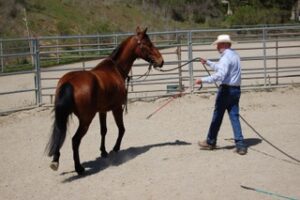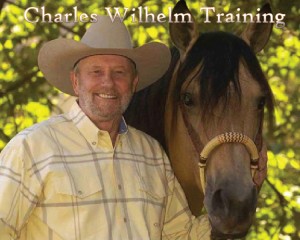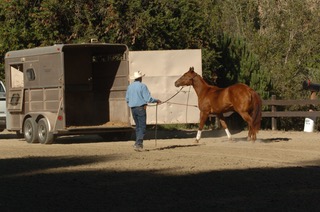– By Charles Wilhelm –
Most horse trainers with solid skills can load almost any horse into a trailer in under 15 minutes. Those of us who specialize in working with problem horses can usually do it in less than five minutes. But loading a horse into a trailer is not a timed event. It is not measured by how fast a horse can be loaded; it should instead be about training the horse to be comfortable with all four components of trailering: loading, standing, riding and unloading. Those elements involve preparation and schooling.
Trailering has several aspects that make most horses nervous. First, we are asking the horse to go into a small, confined, and sometimes dark area. This is counter intuitive to the horse’s natural flight instinct. Second, we are asking the horse to “cross” an object, either by asking the horse to step up into a trailer or to walk up a ramp. Again, the footing issue in both of these makes most horses naturally nervous. Third, we ask the horse to stand and ride in a small, enclosed (often loud) area while the horse is being moved somewhere over which it has no control. Finally, after the horse has been asked to remain upright and steady in a moving container, we then ask it to back out into the unknown.
Let’s face it – trailering really does ask a horse to go against it’s natural instincts in a lot of ways. Do some horses seem to take to it very easily? Yes, there are horses that are naturally compliant, with very low fear levels. If you have one of these horses, chances are teaching your horse to trailer will not be difficult. But, even with a compliant, accepting horse, it does not hurt to school the horse to be comfortable with trailering. The more confident and comfortable your horse is when being trailered, the freer you will be to trail ride, travel to shows or get your horse to a vet in an emergency. Having a horse that reliably loads under any condition is one of the best investments in training time that you can make.
So, where to start? We start with the go-forward cue. The go-forward cue is the critical foundation stone for so many different exercises, and this is especially true for trailer-loading. Please do not start working on asking your horse to load until you have a rock solid go-forward cue developed, at the hips using the same spot every time. Depending on how trained your horse is, this can mean going back to the round pen, but more commonly, going back to line work. The change of direction exercise is a great place to start. And, by the way, do not do these exercises near the trailer in the beginning. Do not even think of adding the trailer into the training program until the go-forward cue is 100% solid. Once you can ask your horse to go forward with good energy, consistently, stop the feet and change direction, then you have completed the first exercise for trailer loading.
For these exercise I use a twelve-foot lead line, a string (also called cowboy) halter and a dressage whip. The twelve-foot lead line gives you a fairly safe working distance, while allowing for a high level of control. The shorter the line, the more control you have. However, with a horse that is extremely emotional, out of control or just plain aggressive, I may start out with a twenty-two-foot line. As the training progresses, I’ll work back to a twelve-foot line. Your initial goal for the line work are pretty simple. You want the horse to move forward in the direction you ask, when you ask. You want him to stop his feet when asked. You want his eyes and overall focus on you. You want him to start seeing you as the center of his life, to be looking for you to give him direction rather than to anticipate. When these are accomplished, you will have gained his respect. Also, this line work exercise is a true cornerstone of foundation training.
So step one – I ask the horse to move out around me clockwise.
Depending on the training and emotional level of the horse, you can use whatever “pressure” is required (a verbal cue, rope, lunge whip, etc.). The trick is to use as little pressure as possible, but as much as you need to get the feet moving in the direction you ask. And, no matter what, stay with it and follow through until the feet are moving. Then, the instant the feet are moving release the pressure to reward the horse. Only reapply the pressure if the horse stops again before you have asked for a “whoa” or halt.

In this exercise I have the horse circle around me several times, anywhere from four to twelve rotations, then I ask for a stop. To teach a horse to stop his feet, you remove the slack from the line and maintain the pressure until he stops. When you are beginning to teach this, especially to a horse with no manners and no regard for pressure, you will have to do more than just take up the slack. You will likely need to start twenty, thirty, or more pounds of pressure to get that horse to stop his feet. Just like when asking the horse to go forward, the key is to use only
as much pressure as you need – never more than that – along with an immediate release of the pressure as soon as the horse stops (gives). Your eventual goal is to have the horse stop his feet as soon as you simply remove a bit of slack from the line. We want this cue to get lighter and lighter. This takes time and lots of practice and patience. We don’t expect success up front as even this initial stage of the training can take up to three or four hours of lesson time.
Once the horse has stopped his feet, I pause for a moment. The pause is very important for several reasons. First, it is a reward – a respite from pressure, and as horses are by nature lazy animals, no movement is a reward in itself. Second, it helps teach the horse to look to you for what to do next and not anticipate. Third, you are training another fundamental building block lesson: the “stand.” Your horse needs to learn to stand to be mounted, at the wash rack, for the farrier, to be groomed and for trailering. This is where it begins.
After a short pause, I ask the horse to do it all over again. Clockwise go-forward several circles, ask for a stop, pause (and praise as needed), and do it all again. Do not change direction or go on to something else until the horse is moving out and stopping his feet well, along with keeping his attention focused on you. Once those are happening consistently and the emotional level has come down, then you can change direction and start all over again in the counter clockwise direction.
The next phase of schooling for trailer loading is to add objects for the horse to cross. Next time we will discuss an exercise to get your horse comfortable with crossing objects and making him comfortable around and near and trailer.
 national clinics and demonstrations.
national clinics and demonstrations. 





















































